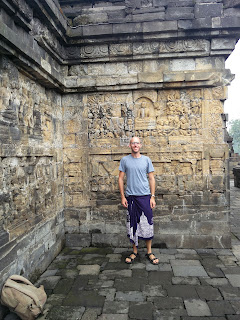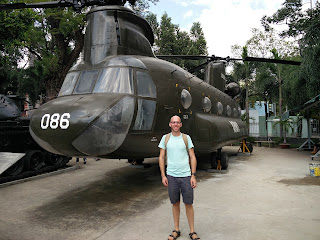On Monday I landed in Malaysia (Malaysia?! I hardly know her!), on a blessedly uneventful Malaysia Airlines flight to Kuala Lumpur. When I was younger, Malaysia used to use the tourism slogan 'Malaysia - truly Asia' in adverts, and I can now confirm that this is accurate, at least in a strictly geographical sense.
At the airport, I was pleasantly relieved to discover that my Israeli-issued credit card was accepted more readily than actual flesh and blood Israelis (read: at all) and I withdrew some Malaysian Ringgit to fund the forthcoming days (later at a shop. Me: "I'd like to know how much this coke costs, could you Ringgit up for me?". Cashier: "eh?"). Armed with said cash, I set about exploring the city, and discovered that, like most places, it was kind of like Belgium and kind of different.
Kuala Lumpur was cleaner and more modern than I expected, especially in comparison to the other Southeast Asian cities I've visited - for one thing, it was a treat being able to dispose of toilet paper directly into the basin. We may have our differences of opinion when it comes to diplomacy, but I have nothing but respect for Malaysian plumbing. The city is full of glitzy shopping centres and gleaming skyscrapers like the Petronas towers, those famous twin buildings inspired by traditional Islamic architecture, which tower over the city Petronas-ly.
In terms of demographics, the population of Malaysia is comprised of three primary ethnic groups - Malays, Chinese and Indians, and Kuala Lumpur represents somewhat of a microcosm of Asia. Chinatown is within walking distance of Kampung Baru, a traditional Malay village that lies in the shadow of the central business district, while at the Hindu temple located within the Batu caves on the outskirts of the city one can feel instantly transplanted to the subcontinent. To be sure, the city feels like a part of the region in which it is located - there were still market vendors greeting me with an effusive fervour that even my parents can't muster, monsoon rains and tropical fruits galore - but compared to Hanoi it felt like a distant step-brother.
A particularly enjoyable moment, on my final night, was having a drink at a bar located on a 34th floor helipad overlooking the city. It was quite exhilarating to gaze at the panorama of an exotic place I had decided to visit only two days prior.
I left Kuala Lumpur by bus for Singapore on Thursday, pausing for a whistlestop visit to the town of Melaka (Melaka ?! I hardly know her!), as Malacca is spelled in the Malay language, and for which the eponymous straits are named. Melaka has an interesting history, having been variously, under British, Dutch and Portuguese control, and it has a diverse mix of colonial architecture to show for it. All in all, I wouldn't describe it as a must-see, but it was a nice way to break up the journey.
As I took my leave from Melaka, I reluctantly parted with my stash of pornography, chewing gum and seditious materials, and prepared to cross the border to the city-state of Singapore, the legendary Asian Tiger - all the cosmopolitan flair of a major world city, without the full raft of pesky civil liberties.
Singapore is like that shopworn cliché of the ostentatiously wealthy Asian uncle at the Passover Seder who's a bit of a stickler for the rules but is a pretty nice guy nonetheless, unless you are harbouring narcotics, in which case your afikoman present is death.
As in Kuala Lumpur, one can find multiple cultures and ethnicities represented in Singapore with each group having its own traditional quarter. The city is reminiscent of Hong Kong in certain ways - the many bank headquarters, the obsession with upscale shopping - but Singapore is cleaner and quieter. The buildings here are less dense and there is an emphasis on free green spaces such as the scenic Botanic Gardens and Gardens by the Bay, both of which I scoped out.
There is a pervasive air of prosperity and sleek efficiency; they're so far ahead of the rest of us that we're gormless troglodytes in comparison. Twice nightly there is a free light and sound show at the Marina Bay, in which images are projected, as though by magic, on to puffs of vapour. The spectacle is exceedingly impressive, like 'vaccine for polio' impressive, though perhaps less of a contribution to the enduring good of humankind. The mass rapid transit system is spotless and punctual. The trains are fully automated, so you can stand at the front where a driver would be seated and watch the train seamlessly glide over the tracks; my ten and eight year old nephews would have loved it. I loved it.
I post this entry at the airport, as I await my flight to the Indonesian island of Bali, located in what's claimed to be the largest hemisphere south of the equator. I plan to be there for around a week before moving on to another Indonesian island.
Have a good week, hell, I'm feeling generous, have a good month.
Love David
 |
| The Petronas Towers |
 |
| Inside the Batu caves |
 |
| View from the helipad bar |
 |
| The strict policies of the Singapore MRT trains. It was particularly difficult finding flame retardant clothes so as to avoid a $500 fine |

































